The Chase
The project
The Chase is a British quiz show running since 2009. Players answer quiz questions to compete as a team against a quiz master, called the Chaser. The game consists of three main sections: the Cash Builder, the Head-to-Head and the Final Chase. This post is the first in a series of exploring statistics of the Chase. In this post, I’ll be exploring the Cash Builder scores and how those scores influence performance during the Head-to-Head round. If you aren’t familiar with the Chase, the Gameplay section of the Wikipedia page has a good overview.
Data
Data for The Chase has been meticulously compiled on One Question Shootout!, ( ). This website has catalogued a massive amount of data for The Chase’s 14 (current) seasons. There is data on each game: if the player or the chaser won, who the chaser was, total prize fund and much more. For each player, there is data on their performance in the Cash Builder, the Head-to-Head, the Final Chase.
The data has been scraped and processed using a script available my GitHub The Chase repo.
The data we don’t have
Unfortunately, there isn’t data on individual data on individual questions. We don’t know what questions were asked, or even how many questions are asked during Cash Builder, Head to Head, and the Final Chase.
Cash Builder
Each player in the show competes in the Cash Builder to increase the overall pot size for the Final Chase, with the correct answer in this phase being worth £1,000. At present this analysis has 6840 data points for Cash Builder performance.
The figure below shows a median score for the Cash Builder to be 5. The distribution of correct answers is more-or-less bell-shaped, with over half of all players scoring between 4-6. The highest score ever is 14, and 0.6% have scored 0.
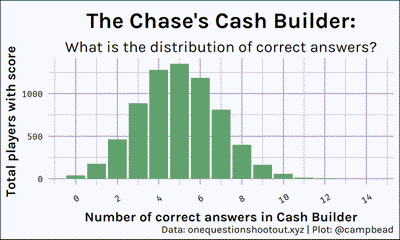
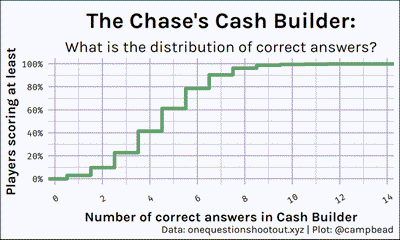
Low, Medium, High
After the Cash Builder players are given the choice of a Higher, Lower, or Middle offer. The middle offer is always £1,000 for each correct answer in the Cash Builder. The Lower and Higher offers are always in fact, lower or higher than the middle offer. The exact amount of the higher and lower offers isn’t prescribed (but perhaps we can analyze what factors influence those in a future post).
Nearly 80 percent of players opt to take the middle offer.
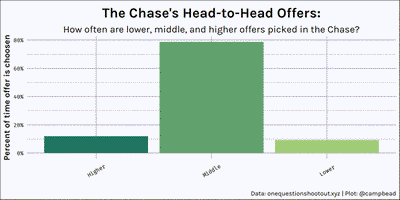
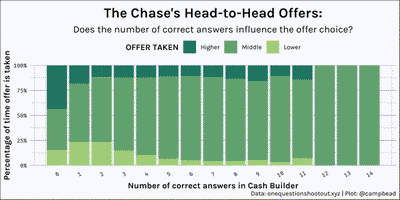
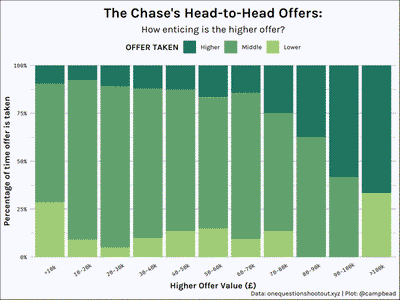
Doing better in the Cash Builder means you’ll do better in the Head-to-Head
We can look at how likely players are to win their Head-to-Head based on the number of correct answers in the Cash Builder and the offer taken. Players are offered a higher offer and lower offer, in addition to the middle offer based on the correct answers during the Cash Builder.
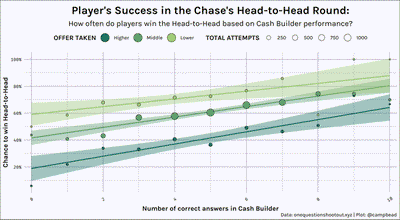
- Value of Low and High doesn’t affect win % We can also look at how the chance of winning the Head-to-Head is affected by the amount of the chosen offer
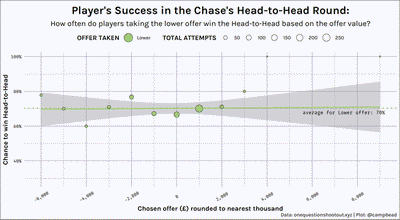
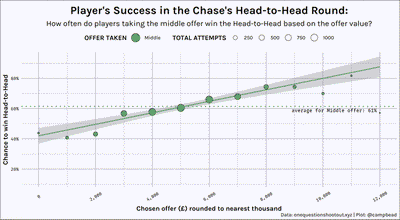
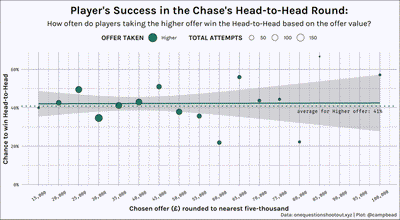
What is clear in the above figures is the chance to win isn’t well correlated to the amount of the chosen offer, except for middle offer which is because is middle offer amount is directly proportional to the number of correct answers during Cash Builder round.
Future topics
This is an ongoing series, in future posts I’ll cover:
- factors influencing the choice of the higher, middle, and lower offers,
- factors influencing the score in the Head-to-Head,
- statistics of the Final Chase.